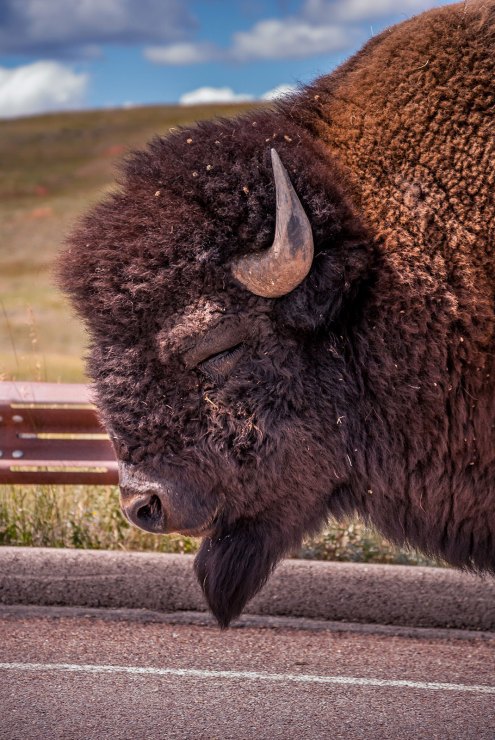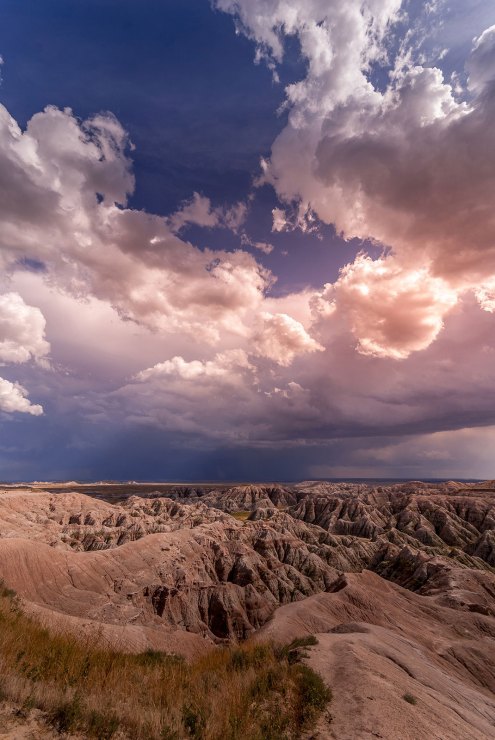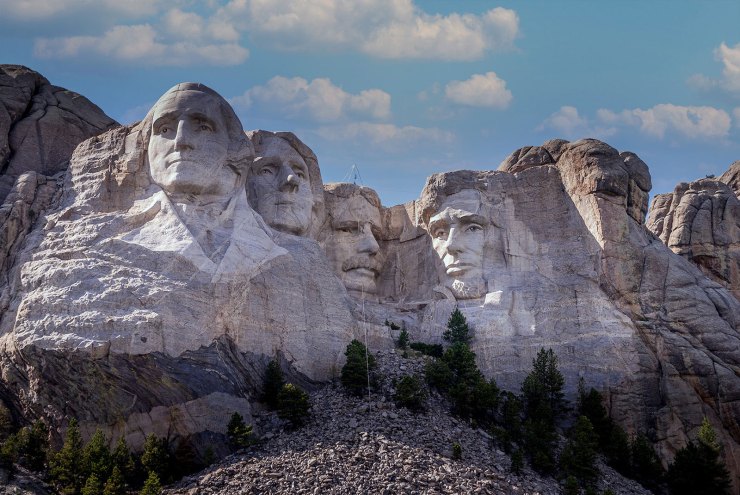South Dakota is home to the largest number of bison anywhere in the United States, so it naturally follows that its state animal is … well, it’s the coyote. Even so, well over thirty thousand bison roam the state in herds owned publicly, privately, and tribally.
These animals are very, very easy to find. If you were to journey through the Black Hills or the Badlands, you’d be almost certain to find hundreds or even thousands of the creatures roaming public land.
A few things about bison: A mature male can weigh over 900 kilograms and stand close to two meters high at the shoulder. That translates to just about a ton of mass, over six feet high. They can move all that bulk as fast as 60 km/h (40 mph) and jump almost two meters vertically. They’re agile, dangerous, unpredictable murder machines and they should be given a wide, wide berth.
Did you miss part one? Be sure to read it here.
Close call
The fact that I somehow — completely unintentionally — wound up within about two or three meters of one of these massive animals in Custer State Park was one incredibly lucky (and at the same time horrifyingly unlucky) moment. It was unlucky in the sense that I wasn’t able to avoid such a close encounter.
I was lucky because I managed to survive such a close encounter. At least I was able to get back into the car before recovering enough of my wits to actually take a photo.

Even if you don’t find the bison (spoiler alert: You WILL find the bison), there’s still plenty to see in and around the Black Hills. Badlands National Park is directly east of those hills, and it’s full of sharply eroded buttes and pinnacles that provide a delight to the eye everywhere you can turn.

Natural forces such as shallow inland seas, rivers, and winds conspired to deposit hypnotic layers of variously colored rocks and minerals in the area. The winds and water stack the rocks onto themselves like some sort of geological layer cake.
The same rivers, along with wind and sand and other elements, are eroding these deposits at a rate of two to three centimeters (about an inch) a year. That is an astonishingly rapid rate of erosion for rocks. In comparison, the granite in the Black Hills is eroded at a rate 10,000 times more slowly.
So, if you want to see this landmark in all its glory, do not waste time. You’ve only got about 500,000 years left before the forces of nature wear the Badlands down to a nub.
Dead Presidents and Tribal Chiefs
We’ve taken a weird little journey away from a lot of the things that most tourists would probably put near the top of their “things to see and do” lists in this state. Let’s finish up in the Black Hills, with a couple of places that just about everyone makes a point of visiting.
Gutzon Borglum was a problematic fellow, to say the least. He was deeply racist and had close ties to the Ku Klux Klan in the the 1920s. The project of carving massive heads into the granite of the Black Hills was born largely of his fascination with themes of supremely patriotic nationalism borne out on a gigantic scale.
A little background
The monument he chose to build was situated on land promised to the Lakota Sioux in the Treaty of Fort Laramie in 1868. But the government forced the tribe to relinquish their rights to the Black Hills portion of the area ceded to them shortly after gold was discovered in the area as white settlers streamed west to make and lose their fortunes. The conflict between the Lakota and the US government culminated in what came to be known as the Wounded Knee Massacre, 10 years before the end of the 19th century.
This was the atmosphere into which Borglum brought his massive ideas, his dynamite and his ambition. This happened 25 years after the horrors of Wounded Knee began the construction of Mount Rushmore. Historian Doane Robinson had originally thought to commemorate American heroes such as Lewis and Clark and Buffalo Bill Cody alongside Sacagawea and Lakota chiefs Red Cloud and Crazy Horse. Borglum instead chose the four presidents that we see today. He had the idea that these men would be more broadly appealing to the tourists that they hoped would be drawn to the area.
Construction began in 1927 and the faces of Washington, Jefferson, Roosevelt and Lincoln (chosen to represent the nation’s birth, growth, development and preservation, respectively) were complete by 1941.

The original plan called for each president to be depicted from head to waist, but lack of funding brought construction to a halt on Halloween of that year.
Crazy Horse
Roughly 20 miles from the Presidents, another massively scaled monument is being carved out of the granite. This one will depict the Oglala Lakota war chief Crazy Horse. He’s mounted on a horse and pointing a finger toward his tribe’s ancestral lands.

Designed by Korczak Ziolkowski, the project was begun in 1948 and continues to this day. The memorial is a nonprofit undertaking and accepts no state or federal funding. Revenue from visitors’ centers, gift shops and private contributions provide the only financing for the project. The intent is that once the sculpture has been completed, it will become the focal point of an educational and cultural center that will include a campus of the University of South Dakota and the Indian Museum of North America.
The installation has not escaped controversy. Its location in the Black Hill, the sacred burial ground of the Lakota Sioux, has prompted traditionalists among the tribe to oppose the memorial as an affront to their culture and beliefs.
Pack your bags and head to South Dakota
South Dakota is a big place, and although it’s wide open and empty, we’ve really only begun to scratch the surface of the places to visit and the things to see in this state. Maybe it’s time to get back to traveling the way we used to. Hop in the car and get to know not only the places where you’re going but also the stops along the way.
There’s much that’s so easy to miss when you take the quick and easy way to get from point A to point B. All I know is that never being able to experience everything in between — or at least some of the things in between — would be a real shame.
Editor’s Note: We welcome this guest post by Eustace James. Eustace is a cybersecurity professional and computer geek at heart. He’s also a hobby photographer of nearly 40 years who loves travel, live music and traveling to see live music. He makes his home just north of Toronto, Canada, but is more likely to be found in a dive bar in some North American city listening to oppressively loud tunes played by some band you’ve never heard of. You can find Eustace on Twitter and Instagram.
Tell your story with the second annual Visual Storytelling Conference!
Experience four days of interactive, online training sessions featuring a range of educational content with experienced photographers and content creators. This free event kicks off with a series of technical boot camps to build essential skills, followed by live, online sessions on photography, video, business and social media. Join live from March 10-13, 2022!
